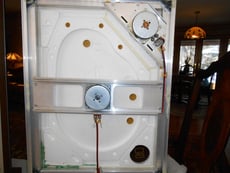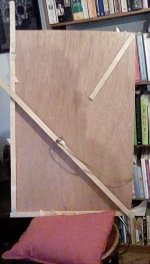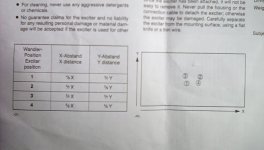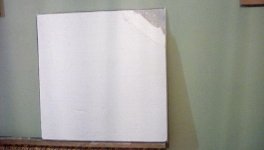On the subject of corners flapping, this is a photo I found of my problem panel and the way I stopped the free corner from flapping.
Maybe rounding the corner could have done the job just as well ?
but the flapping was very bad,so I'm not sure ?
steve.
Maybe rounding the corner could have done the job just as well ?
but the flapping was very bad,so I'm not sure ?
steve.
I should point out that the reason the flapping was made worse was the clamping of the two sides and the spine.
This created a sort of whiplash affect , a bit like holding a very long stick at one end and shaking it with the other hand,similar to a fishing rod.
All part of the learning curve 😀
Steve.
This created a sort of whiplash affect , a bit like holding a very long stick at one end and shaking it with the other hand,similar to a fishing rod.
All part of the learning curve 😀
Steve.
Last edited:
2 exciters on each form board, advice please
I have 4Ohm exciters and plan to use 2 on each 2x2 ft form board from HD, will use serial connection. My amplifier is rated at 8Ohms 100W/ch. My question is
1. will it be better to use larger board, perhaps 2x3' ?
2. is there any recommendation on where to mount the exciters on the panel.
thanks,
I have 4Ohm exciters and plan to use 2 on each 2x2 ft form board from HD, will use serial connection. My amplifier is rated at 8Ohms 100W/ch. My question is
1. will it be better to use larger board, perhaps 2x3' ?
2. is there any recommendation on where to mount the exciters on the panel.
thanks,
Hi,
I've just started going down the rabbit hole of DML speakers.
After all those years experimenting, do you have any advice for wall mounting the speakers? From all I have read:
- no direct contact to the wall, either decoupled by string or sponge
- mount as far as possible away from the wall
- add some speaker cotton between panel and wall can work
Size will be 500x400mm with an DAEX25FHE-4.
Not sure about the material at the moment, will try a few things:
- 10mm XPS foam
- 4mm Plywood probably poplar, I think beech could be to heavy for the exciter.
What I want to try, but not sure if this works:
1-2mm aluminium with 10mm XPS or EPS foam on the back. The foam CNC'd to have an ear-shape thinned in the middle and being thick on the outside to dampen the aluminium.
I've just started going down the rabbit hole of DML speakers.
After all those years experimenting, do you have any advice for wall mounting the speakers? From all I have read:
- no direct contact to the wall, either decoupled by string or sponge
- mount as far as possible away from the wall
- add some speaker cotton between panel and wall can work
Size will be 500x400mm with an DAEX25FHE-4.
Not sure about the material at the moment, will try a few things:
- 10mm XPS foam
- 4mm Plywood probably poplar, I think beech could be to heavy for the exciter.
What I want to try, but not sure if this works:
1-2mm aluminium with 10mm XPS or EPS foam on the back. The foam CNC'd to have an ear-shape thinned in the middle and being thick on the outside to dampen the aluminium.
I recall one easy thing to try is to use art store pre-stretched canvas painting blanks and place a felt blanket on the back. I recall that an aluminum soda can bottom can be used right where the driver is to enhance the highs like a dome tweeter. This was suggested by someone a while back (in this thread). I bought some canvas prestretched frames to try out but never got around to it.
Edit - I think it was Spedge and Todincabo who did this:
A Study of DML's as a Full Range Speaker
A Study of DML's as a Full Range Speaker
Edit - I think it was Spedge and Todincabo who did this:
A Study of DML's as a Full Range Speaker
A Study of DML's as a Full Range Speaker
Last edited:
Xrk971.
It was someone else who used the bottom of cans to make a rather large dome.
This is too big and heavy for my needs.
Steve.
It was someone else who used the bottom of cans to make a rather large dome.
This is too big and heavy for my needs.
Steve.
Gychang.
NXT positions for mounting exciters.
Parts express have a different ratio.
Some use a two thirds method.
Take your pick ?
Steve.
thanks, not an exact science...😕
In my testing of exciter positions, not scientif and only based on my hearing, I found that there does not seem to be any real difference when using just a single excitor on excitor positioning.
I've tried the golden and silver positions of NXT, the 2 fifths/3 fifths positions of parts express, the 1/3 2/3 position mentioned by a very early experimenter (back in 2005 I believe his paper is still available in one of the long DML threads, though don't ask me where.) And I finally did a critical listening test by using a panel sitting horizontally flat held up barely by resting the four corners on 4 separate kitchen table chairs. I then visually divided the panel into 4 seperate and equal quadrants. Technically all 4 quadrants should test the same and I simply wanted to cut down on all the possible locations to test. I placed the exciter on top of the panel surface in one quadrant and slowly moved the excitor across the surface stopping every centimeter or so to listen to the output. After several hours of listening to this slow moment across the panel qaudrant in all directions, I came to the stunning conclusion that I could not reliably hear any difference in the sound level coming from any point in the quadrant. I listened especially to all the supposed nodal points mentioned by the above "scientific measurements" and simply could not with any accuracy at all hear any differences though I should have been able to hear loudness differences at the nodal points. It was just too subtle for my hearing (and yes my hearing is not the best and my top end goes up to only about 14-15K). There were a couple times I thought I could hear a slight difference in some areas that fell into the 2 fifths/3 fifth's paradigm but repeated testing just didn't pan out. From what I've read there should be a noticeable loudness difference at the nodal points but I could not hear it with any predictability.
As for further details, I tried this using the Dayton 24W excitor both with no extra weight on it and with a little extra weight on it (of course no permanent mounting of the excitor was done at any position.) I played white noise through the excitor which should have given me equal levels of sound from 20-20Khz across the spectrum so that I would potentially hit any resonant frequency node on the panel if there was one.
Needless to say I was surprised that I could not in any way reliably pick a spot in the quadrant that was "best". There may be but it must be extremely subtle and nothing like those chandra plate setups where the nodal points are explicit and very discernible. If I had more time and patience I would have put some sand or sugar across the panel and see if there where any visible nodal points.
But the more I thought about it, the more I was thinking that the chandra plate examples were always using single freq's not a broad spectrum of freq's like I used and more what you would expect from music itself. I'm definitely no expert in this field and just playing around so take what I say with the usual grain of salt, anecdotal info...
My bottom line right now is that I'm not seeing the difference that any of the mentioned mounting points is any better than another in real world usage, so I just stick to using the general area around where the above measurements claim to be best (i.e., if you plotted all three of those points mentioned and then drew a circle around them you would see they all fit into a pretty general small area and I just stick to that.)
Hows that for the scientific method lol...
I've tried the golden and silver positions of NXT, the 2 fifths/3 fifths positions of parts express, the 1/3 2/3 position mentioned by a very early experimenter (back in 2005 I believe his paper is still available in one of the long DML threads, though don't ask me where.) And I finally did a critical listening test by using a panel sitting horizontally flat held up barely by resting the four corners on 4 separate kitchen table chairs. I then visually divided the panel into 4 seperate and equal quadrants. Technically all 4 quadrants should test the same and I simply wanted to cut down on all the possible locations to test. I placed the exciter on top of the panel surface in one quadrant and slowly moved the excitor across the surface stopping every centimeter or so to listen to the output. After several hours of listening to this slow moment across the panel qaudrant in all directions, I came to the stunning conclusion that I could not reliably hear any difference in the sound level coming from any point in the quadrant. I listened especially to all the supposed nodal points mentioned by the above "scientific measurements" and simply could not with any accuracy at all hear any differences though I should have been able to hear loudness differences at the nodal points. It was just too subtle for my hearing (and yes my hearing is not the best and my top end goes up to only about 14-15K). There were a couple times I thought I could hear a slight difference in some areas that fell into the 2 fifths/3 fifth's paradigm but repeated testing just didn't pan out. From what I've read there should be a noticeable loudness difference at the nodal points but I could not hear it with any predictability.
As for further details, I tried this using the Dayton 24W excitor both with no extra weight on it and with a little extra weight on it (of course no permanent mounting of the excitor was done at any position.) I played white noise through the excitor which should have given me equal levels of sound from 20-20Khz across the spectrum so that I would potentially hit any resonant frequency node on the panel if there was one.
Needless to say I was surprised that I could not in any way reliably pick a spot in the quadrant that was "best". There may be but it must be extremely subtle and nothing like those chandra plate setups where the nodal points are explicit and very discernible. If I had more time and patience I would have put some sand or sugar across the panel and see if there where any visible nodal points.
But the more I thought about it, the more I was thinking that the chandra plate examples were always using single freq's not a broad spectrum of freq's like I used and more what you would expect from music itself. I'm definitely no expert in this field and just playing around so take what I say with the usual grain of salt, anecdotal info...
My bottom line right now is that I'm not seeing the difference that any of the mentioned mounting points is any better than another in real world usage, so I just stick to using the general area around where the above measurements claim to be best (i.e., if you plotted all three of those points mentioned and then drew a circle around them you would see they all fit into a pretty general small area and I just stick to that.)
Hows that for the scientific method lol...
Can anyone else post their EQ settings? I'm pretty happy with mine after trying to figure out how to calibrate them for an hour at least. I'd love to compare (mine are on Spotify).

As for the panels, these are uncannily good. The secret sauce seems to be the 1:1 Water/PVA glue mix. I originally made the speakers without it as based on the TI video (w/ 25w exciters from DA), and was fairly underwhelmed. With a bit of research I found this thread and decided to go for it. Its really a completely different experience. It added in a lot more low-end which was lacking earlier as well.
With that, and hanging my wires so they didn't touch the panel when it vibrated, as well as the EQ, they are shockingly close to the $10,000 tower speaker system we have for our TV. I've never given audio much thought before, but this was a really cool experience! I haven't been able to use them with TIDAL just yet, but am interested to see whether I can hear the difference b/w lossless and Spotify on them.
If anyone has some other tips or mods for it, I'd love to hear them!

As for the panels, these are uncannily good. The secret sauce seems to be the 1:1 Water/PVA glue mix. I originally made the speakers without it as based on the TI video (w/ 25w exciters from DA), and was fairly underwhelmed. With a bit of research I found this thread and decided to go for it. Its really a completely different experience. It added in a lot more low-end which was lacking earlier as well.
With that, and hanging my wires so they didn't touch the panel when it vibrated, as well as the EQ, they are shockingly close to the $10,000 tower speaker system we have for our TV. I've never given audio much thought before, but this was a really cool experience! I haven't been able to use them with TIDAL just yet, but am interested to see whether I can hear the difference b/w lossless and Spotify on them.
If anyone has some other tips or mods for it, I'd love to hear them!
Gychang and geosand.
This patent explains why the NXT positions are used.
And a lot more.
It's not about volume but the spreading of frequencies for a smoother response,with less dips and peaks
Steve.
US20060159293A1 - Acoustic device
- Google Patents
This patent explains why the NXT positions are used.
And a lot more.
It's not about volume but the spreading of frequencies for a smoother response,with less dips and peaks
Steve.
US20060159293A1 - Acoustic device
- Google Patents
As for the panels, these are uncannily good. The secret sauce seems to be the 1:1 Water/PVA glue mix. It added in a lot more low-end which was lacking earlier as well.
will a mixtuer of Elmer's white glue and water do the job, on all the surface including front/back/sides?
Whyme1.
This is a very old panel that has been bashed around a bit over the years.
It is 0.5 mmm Ali and 5mmm eps glued together.
Should have thrown it away years ago.
This is a heavy over damped panel.
Steve.
Thanks for the response. Not exactly what I wanted top so.
If you look at this speaker:

There is a thinned down area in the middle plus some "counterweights" I assume to dampen some frequencies.
If you would throw your panel away anyways, could you give it a try and remove some of the foam in the middle, similar shape as in the picture.
Whyme1.
The speaker in the photo is a BES .
Which is a sort of hybrid which has a bass mid ,a mid and a piezoelectric tweeter.
There is no sheet Ali involved .
The large panel is pretty thick in the centre exciter area and thins out towards the ear shape .
Steve.
The speaker in the photo is a BES .
Which is a sort of hybrid which has a bass mid ,a mid and a piezoelectric tweeter.
There is no sheet Ali involved .
The large panel is pretty thick in the centre exciter area and thins out towards the ear shape .
Steve.
will a mixtuer of Elmer's white glue and water do the job, on all the surface including front/back/sides?
I left the edges empty. So front and back for both panels, and 2 layers each.
As for the glue, Elmers should work. I personally used Gorilla, but they're both PVA glue so it shouldn't have much of a difference
Latest DML vids on YT...
Some YT finds, not my videos...
Typical Ben
My Bamboo Panel DML Speakers Sound Amazing!
Description:
Typical Ben
9 subscribers
To see how I made these panels, see my video here: How I made my Bamboo DML Speakers - YouTube
I recorded a few random clips of my bamboo panels in action this morning for anyone who's interested in this material, hanging design or DMLs in general.
Clips were recorded on my Fujifilm mirrorless with Rode Videomicro mic (RODE VMICRORode VideoMicro Ultra-Compact Directional On-Camera Microphone : Amazon.com.au: Musical Instruments)
I know you can't get much detail from recordings like this but I hope it at least shows that you can get decent sound out of a pretty basic design (these are my first attempt). The recording does sound more 'room-ey' than it does in person. I've read that the diffuse nature of these panels makes room behavior less noticeable to our ears - maybe not so much to the mic?
I put these together a couple of months ago after watching the tech ingredients videos. Unlike that guy I don't have a huge wall to use so I came up with this simple design to allow me to free-hang a pair of smaller panels.
The frames are a pair of bamboo clothes racks that I cut down in height and width (frame height is 1100mm). The panel is 2.5mm carbonised bamboo laserply, which is designed for laser-cutting applications. Panel dimensions are 900 x 400mm. You can see my experiments with bracing the panels in the video - at 2.5mm it's not quite stiff enough as a free-hanging panel.
I'm using Dayton Thruster 32mm exciters, free floating as you can see. They're attached at dead center on one panel and 2/5 - 3/5 on the other.
Overall I've been blown away by the sound of these - vocal tracks especially seem to leap right out with presence and clarity that is frankly unreasonable for speakers that cost this much.
They do lack bass though (no surprise) and roll off pretty hard below about 200hz, so I use a Canton 10.3 active subwoofer to fill in the low end. I have also applied some broad EQ via a MiniDSP 4x2 in the tape loop of my amp.
The main thing I want to improve is what I'd call 'punch' - they do sound pretty laid back which is great for some music but not all, obviously.
I have two other builds in mind - a floorstanding, framed clear acrylic pair and a 4-panel bamboo pair - please subscribe and ding dat bell if you're interested in seeing those builds!
Some YT finds, not my videos...
Typical Ben
My Bamboo Panel DML Speakers Sound Amazing!
Description:
Typical Ben
9 subscribers
To see how I made these panels, see my video here: How I made my Bamboo DML Speakers - YouTube
I recorded a few random clips of my bamboo panels in action this morning for anyone who's interested in this material, hanging design or DMLs in general.
Clips were recorded on my Fujifilm mirrorless with Rode Videomicro mic (RODE VMICRORode VideoMicro Ultra-Compact Directional On-Camera Microphone : Amazon.com.au: Musical Instruments)
I know you can't get much detail from recordings like this but I hope it at least shows that you can get decent sound out of a pretty basic design (these are my first attempt). The recording does sound more 'room-ey' than it does in person. I've read that the diffuse nature of these panels makes room behavior less noticeable to our ears - maybe not so much to the mic?
I put these together a couple of months ago after watching the tech ingredients videos. Unlike that guy I don't have a huge wall to use so I came up with this simple design to allow me to free-hang a pair of smaller panels.
The frames are a pair of bamboo clothes racks that I cut down in height and width (frame height is 1100mm). The panel is 2.5mm carbonised bamboo laserply, which is designed for laser-cutting applications. Panel dimensions are 900 x 400mm. You can see my experiments with bracing the panels in the video - at 2.5mm it's not quite stiff enough as a free-hanging panel.
I'm using Dayton Thruster 32mm exciters, free floating as you can see. They're attached at dead center on one panel and 2/5 - 3/5 on the other.
Overall I've been blown away by the sound of these - vocal tracks especially seem to leap right out with presence and clarity that is frankly unreasonable for speakers that cost this much.
They do lack bass though (no surprise) and roll off pretty hard below about 200hz, so I use a Canton 10.3 active subwoofer to fill in the low end. I have also applied some broad EQ via a MiniDSP 4x2 in the tape loop of my amp.
The main thing I want to improve is what I'd call 'punch' - they do sound pretty laid back which is great for some music but not all, obviously.
I have two other builds in mind - a floorstanding, framed clear acrylic pair and a 4-panel bamboo pair - please subscribe and ding dat bell if you're interested in seeing those builds!
- Home
- Loudspeakers
- Full Range
- A Study of DMLs as a Full Range Speaker


